ECU CHEVROLET AVEO 2007 1.G Owners Manual
[x] Cancel search | Manufacturer: CHEVROLET, Model Year: 2007, Model line: AVEO, Model: CHEVROLET AVEO 2007 1.GPages: 436, PDF Size: 2.52 MB
Page 7 of 436
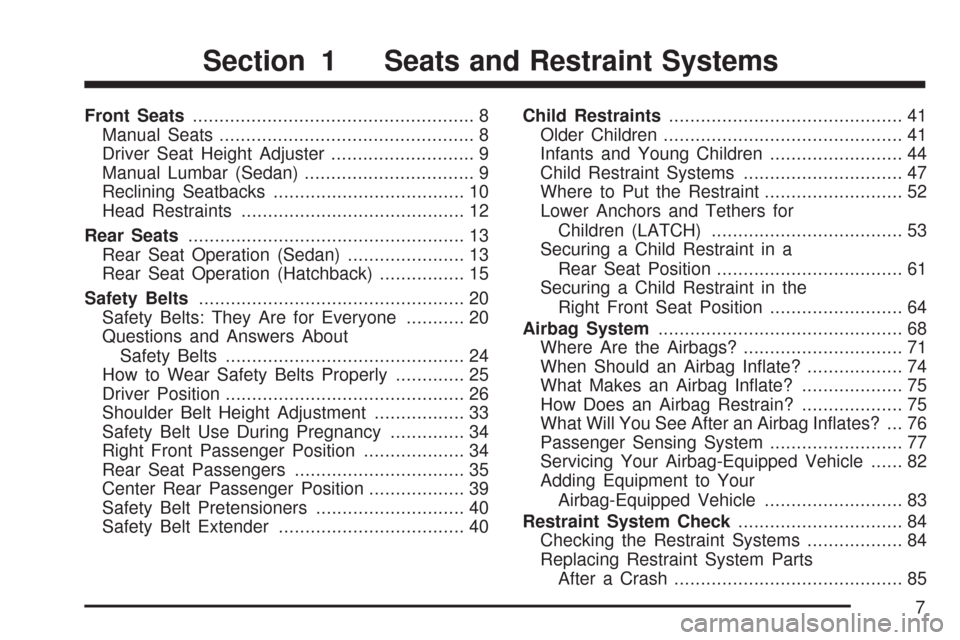
Front Seats..................................................... 8
Manual Seats................................................ 8
Driver Seat Height Adjuster........................... 9
Manual Lumbar (Sedan)................................ 9
Reclining Seatbacks.................................... 10
Head Restraints.......................................... 12
Rear Seats.................................................... 13
Rear Seat Operation (Sedan)...................... 13
Rear Seat Operation (Hatchback)................ 15
Safety Belts.................................................. 20
Safety Belts: They Are for Everyone........... 20
Questions and Answers About
Safety Belts............................................. 24
How to Wear Safety Belts Properly............. 25
Driver Position............................................. 26
Shoulder Belt Height Adjustment................. 33
Safety Belt Use During Pregnancy.............. 34
Right Front Passenger Position................... 34
Rear Seat Passengers................................ 35
Center Rear Passenger Position.................. 39
Safety Belt Pretensioners............................ 40
Safety Belt Extender................................... 40Child Restraints............................................ 41
Older Children............................................. 41
Infants and Young Children......................... 44
Child Restraint Systems.............................. 47
Where to Put the Restraint.......................... 52
Lower Anchors and Tethers for
Children (LATCH).................................... 53
Securing a Child Restraint in a
Rear Seat Position................................... 61
Securing a Child Restraint in the
Right Front Seat Position......................... 64
Airbag System.............................................. 68
Where Are the Airbags?.............................. 71
When Should an Airbag Inflate?.................. 74
What Makes an Airbag Inflate?................... 75
How Does an Airbag Restrain?................... 75
What Will You See After an Airbag Inflates? ... 76
Passenger Sensing System......................... 77
Servicing Your Airbag-Equipped Vehicle...... 82
Adding Equipment to Your
Airbag-Equipped Vehicle.......................... 83
Restraint System Check............................... 84
Checking the Restraint Systems.................. 84
Replacing Restraint System Parts
After a Crash........................................... 85
Section 1 Seats and Restraint Systems
7
Page 14 of 436
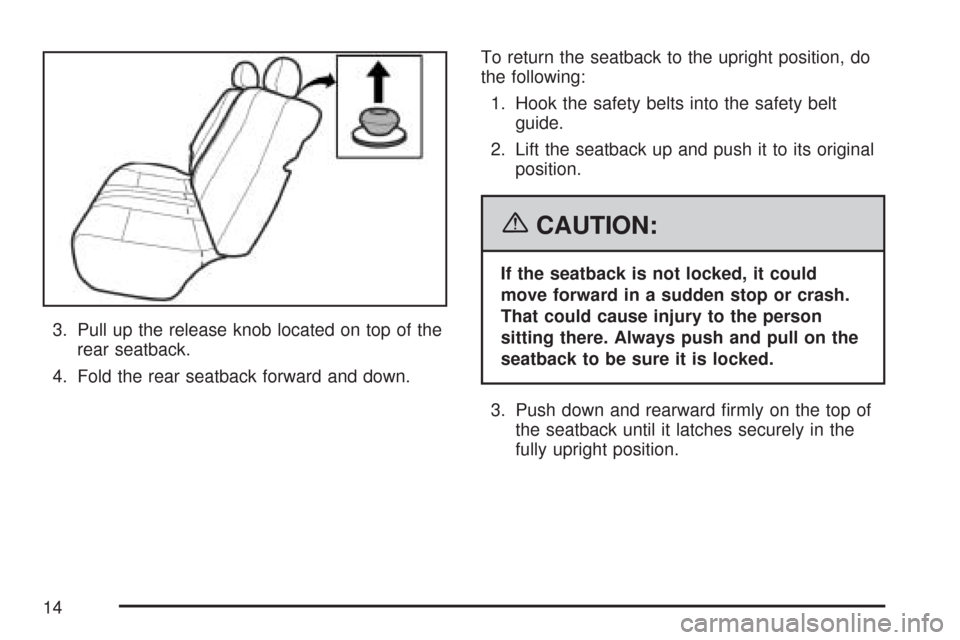
3. Pull up the release knob located on top of the
rear seatback.
4. Fold the rear seatback forward and down.To return the seatback to the upright position, do
the following:
1. Hook the safety belts into the safety belt
guide.
2. Lift the seatback up and push it to its original
position.
{CAUTION:
If the seatback is not locked, it could
move forward in a sudden stop or crash.
That could cause injury to the person
sitting there. Always push and pull on the
seatback to be sure it is locked.
3. Push down and rearward firmly on the top of
the seatback until it latches securely in the
fully upright position.
14
Page 17 of 436
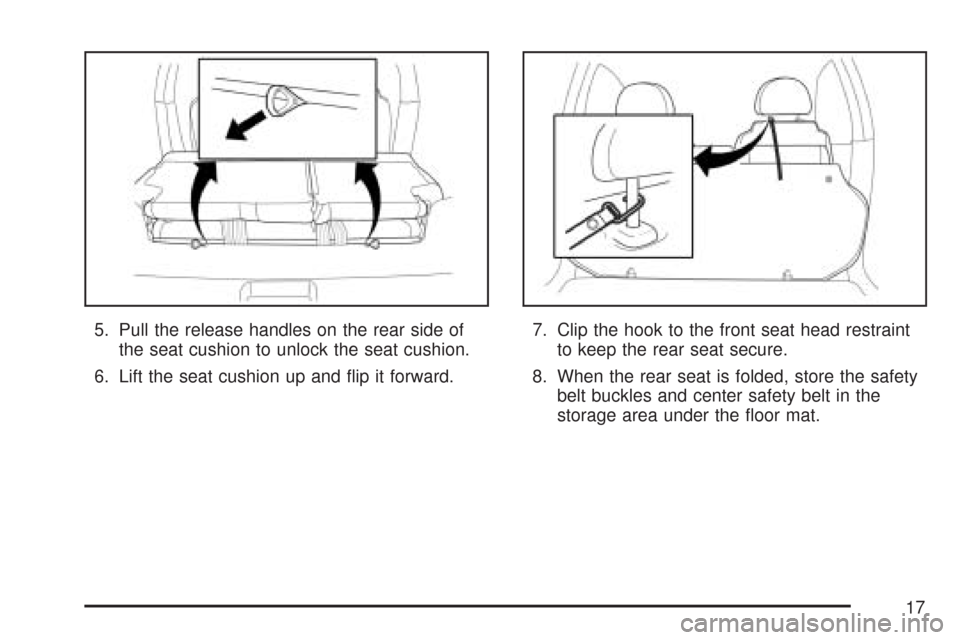
5. Pull the release handles on the rear side of
the seat cushion to unlock the seat cushion.
6. Lift the seat cushion up and flip it forward.7. Clip the hook to the front seat head restraint
to keep the rear seat secure.
8. When the rear seat is folded, store the safety
belt buckles and center safety belt in the
storage area under the floor mat.
17
Page 18 of 436
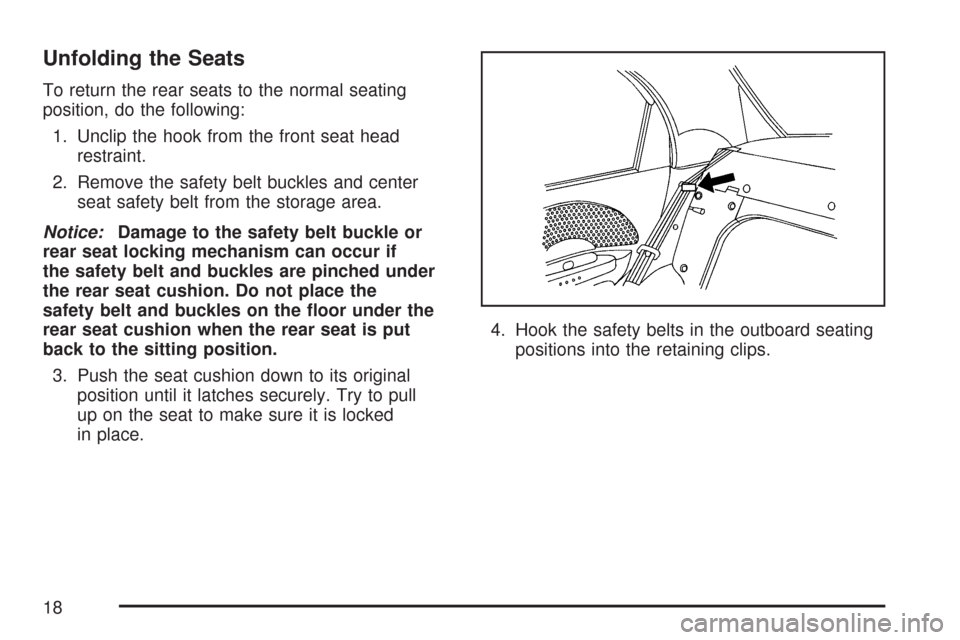
Unfolding the Seats
To return the rear seats to the normal seating
position, do the following:
1. Unclip the hook from the front seat head
restraint.
2. Remove the safety belt buckles and center
seat safety belt from the storage area.
Notice:Damage to the safety belt buckle or
rear seat locking mechanism can occur if
the safety belt and buckles are pinched under
the rear seat cushion. Do not place the
safety belt and buckles on the �oor under the
rear seat cushion when the rear seat is put
back to the sitting position.
3. Push the seat cushion down to its original
position until it latches securely. Try to pull
up on the seat to make sure it is locked
in place.4. Hook the safety belts in the outboard seating
positions into the retaining clips.
18
Page 19 of 436
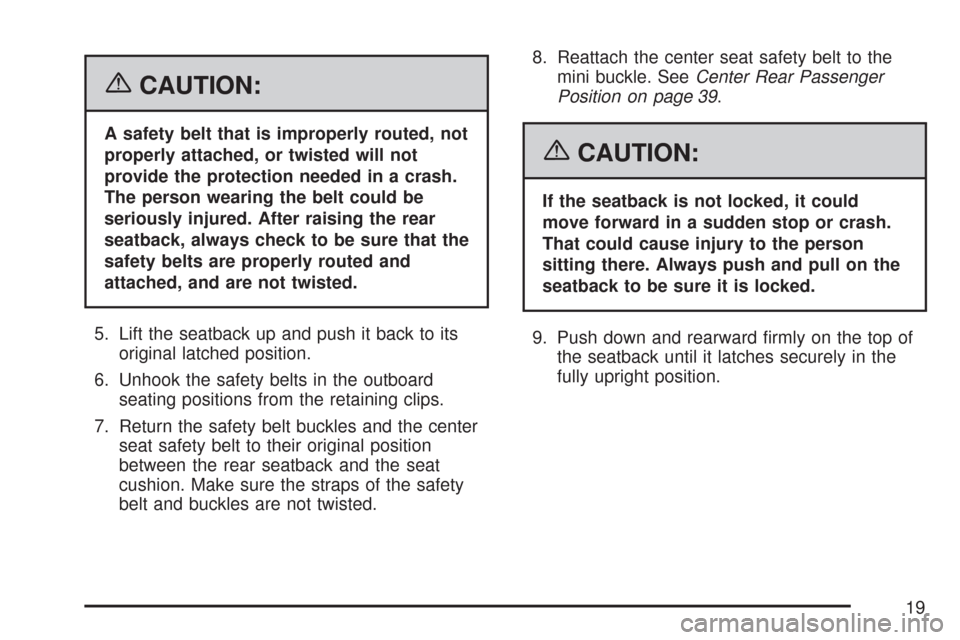
{CAUTION:
A safety belt that is improperly routed, not
properly attached, or twisted will not
provide the protection needed in a crash.
The person wearing the belt could be
seriously injured. After raising the rear
seatback, always check to be sure that the
safety belts are properly routed and
attached, and are not twisted.
5. Lift the seatback up and push it back to its
original latched position.
6. Unhook the safety belts in the outboard
seating positions from the retaining clips.
7. Return the safety belt buckles and the center
seat safety belt to their original position
between the rear seatback and the seat
cushion. Make sure the straps of the safety
belt and buckles are not twisted.8. Reattach the center seat safety belt to the
mini buckle. SeeCenter Rear Passenger
Position on page 39.
{CAUTION:
If the seatback is not locked, it could
move forward in a sudden stop or crash.
That could cause injury to the person
sitting there. Always push and pull on the
seatback to be sure it is locked.
9. Push down and rearward firmly on the top of
the seatback until it latches securely in the
fully upright position.
19
Page 26 of 436
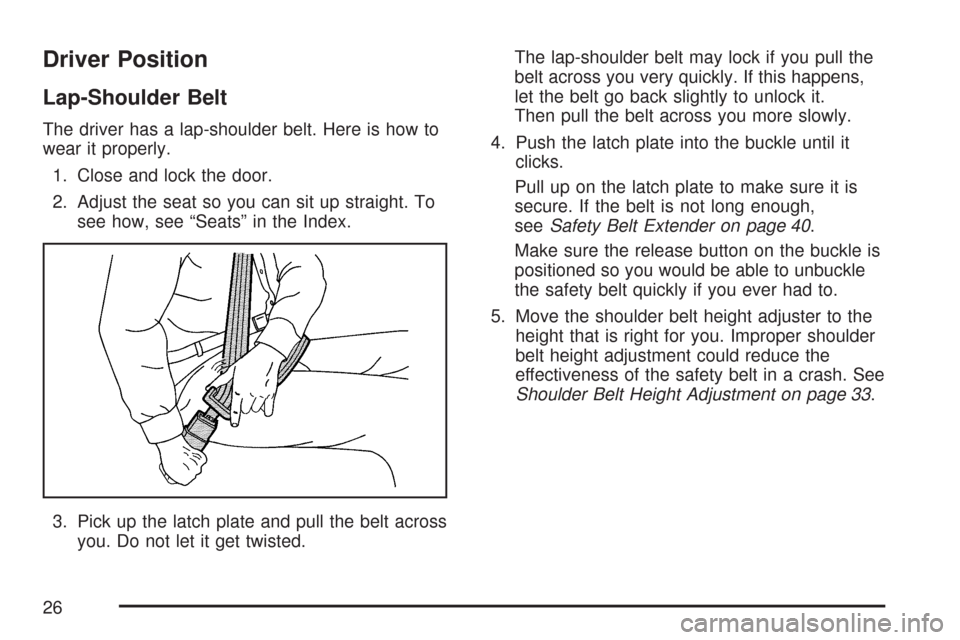
Driver Position
Lap-Shoulder Belt
The driver has a lap-shoulder belt. Here is how to
wear it properly.
1. Close and lock the door.
2. Adjust the seat so you can sit up straight. To
see how, see “Seats” in the Index.
3. Pick up the latch plate and pull the belt across
you. Do not let it get twisted.The lap-shoulder belt may lock if you pull the
belt across you very quickly. If this happens,
let the belt go back slightly to unlock it.
Then pull the belt across you more slowly.
4. Push the latch plate into the buckle until it
clicks.
Pull up on the latch plate to make sure it is
secure. If the belt is not long enough,
seeSafety Belt Extender on page 40.
Make sure the release button on the buckle is
positioned so you would be able to unbuckle
the safety belt quickly if you ever had to.
5. Move the shoulder belt height adjuster to the
height that is right for you. Improper shoulder
belt height adjustment could reduce the
effectiveness of the safety belt in a crash. See
Shoulder Belt Height Adjustment on page 33.
26
Page 36 of 436
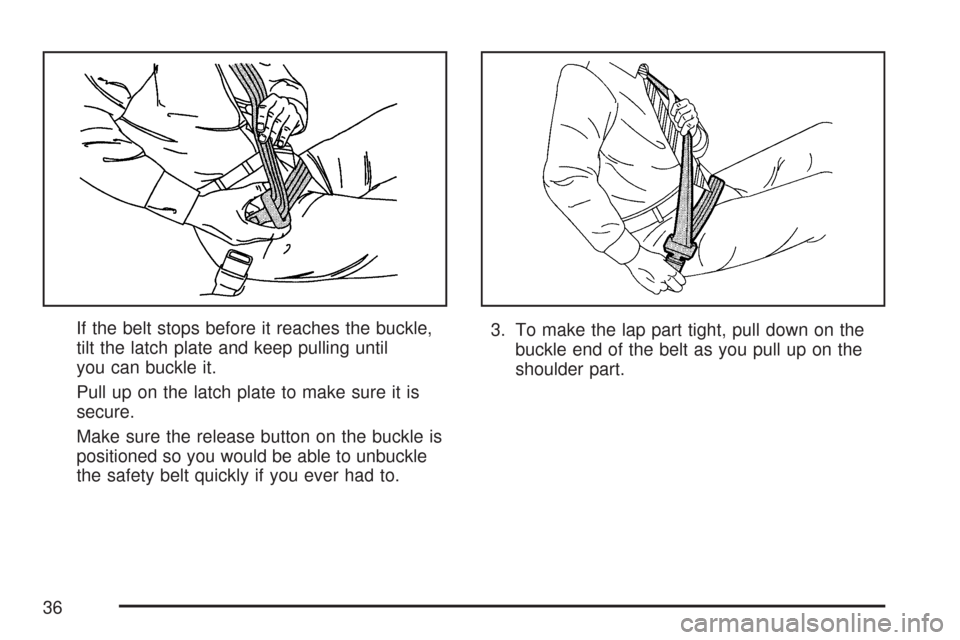
If the belt stops before it reaches the buckle,
tilt the latch plate and keep pulling until
you can buckle it.
Pull up on the latch plate to make sure it is
secure.
Make sure the release button on the buckle is
positioned so you would be able to unbuckle
the safety belt quickly if you ever had to.3. To make the lap part tight, pull down on the
buckle end of the belt as you pull up on the
shoulder part.
36
Page 39 of 436
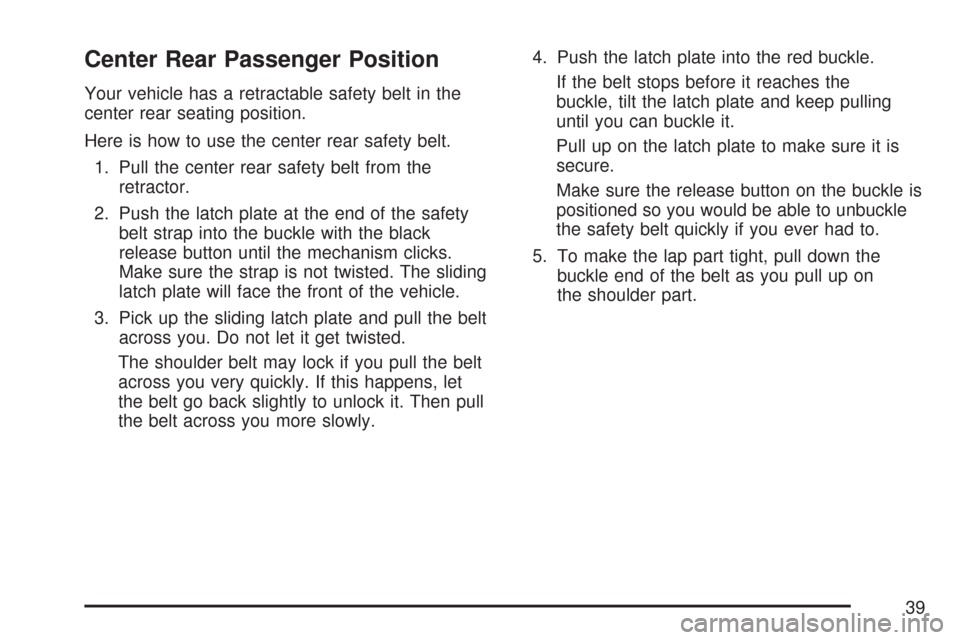
Center Rear Passenger Position
Your vehicle has a retractable safety belt in the
center rear seating position.
Here is how to use the center rear safety belt.
1. Pull the center rear safety belt from the
retractor.
2. Push the latch plate at the end of the safety
belt strap into the buckle with the black
release button until the mechanism clicks.
Make sure the strap is not twisted. The sliding
latch plate will face the front of the vehicle.
3. Pick up the sliding latch plate and pull the belt
across you. Do not let it get twisted.
The shoulder belt may lock if you pull the belt
across you very quickly. If this happens, let
the belt go back slightly to unlock it. Then pull
the belt across you more slowly.4. Push the latch plate into the red buckle.
If the belt stops before it reaches the
buckle, tilt the latch plate and keep pulling
until you can buckle it.
Pull up on the latch plate to make sure it is
secure.
Make sure the release button on the buckle is
positioned so you would be able to unbuckle
the safety belt quickly if you ever had to.
5. To make the lap part tight, pull down the
buckle end of the belt as you pull up on
the shoulder part.
39
Page 40 of 436
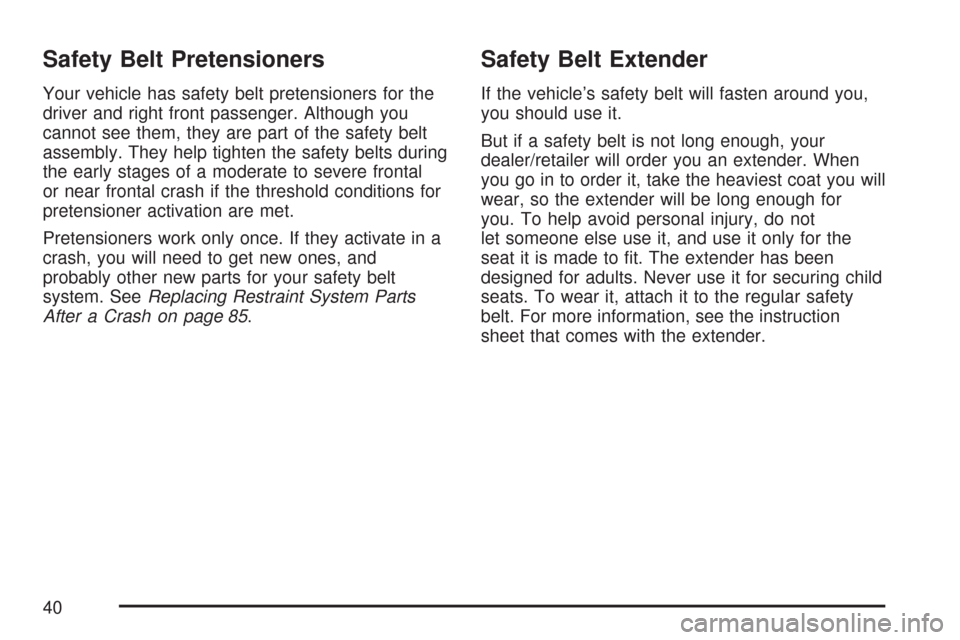
Safety Belt Pretensioners
Your vehicle has safety belt pretensioners for the
driver and right front passenger. Although you
cannot see them, they are part of the safety belt
assembly. They help tighten the safety belts during
the early stages of a moderate to severe frontal
or near frontal crash if the threshold conditions for
pretensioner activation are met.
Pretensioners work only once. If they activate in a
crash, you will need to get new ones, and
probably other new parts for your safety belt
system. SeeReplacing Restraint System Parts
After a Crash on page 85.
Safety Belt Extender
If the vehicle’s safety belt will fasten around you,
you should use it.
But if a safety belt is not long enough, your
dealer/retailer will order you an extender. When
you go in to order it, take the heaviest coat you will
wear, so the extender will be long enough for
you. To help avoid personal injury, do not
let someone else use it, and use it only for the
seat it is made to fit. The extender has been
designed for adults. Never use it for securing child
seats. To wear it, attach it to the regular safety
belt. For more information, see the instruction
sheet that comes with the extender.
40
Page 44 of 436
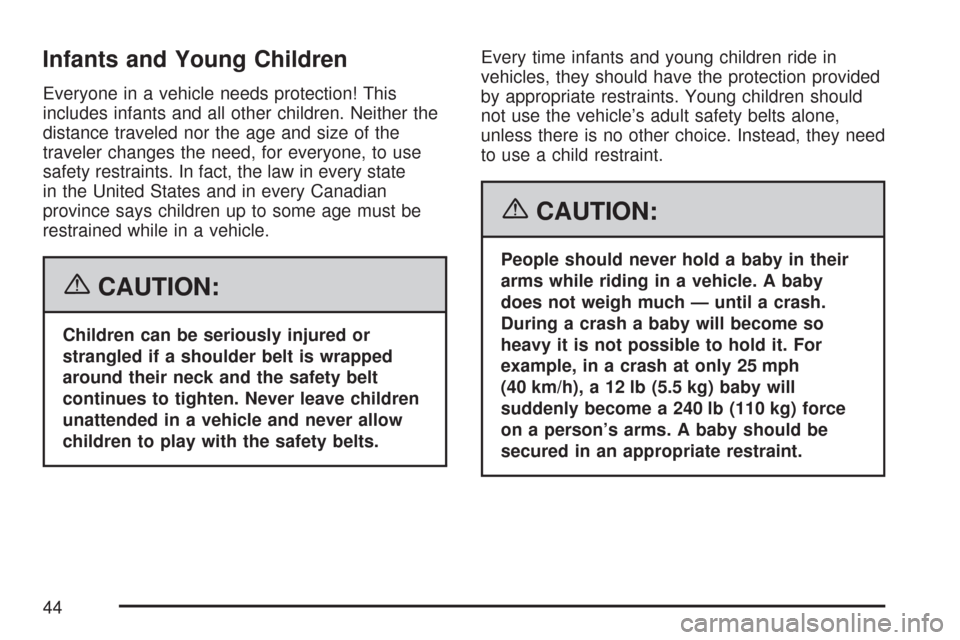
Infants and Young Children
Everyone in a vehicle needs protection! This
includes infants and all other children. Neither the
distance traveled nor the age and size of the
traveler changes the need, for everyone, to use
safety restraints. In fact, the law in every state
in the United States and in every Canadian
province says children up to some age must be
restrained while in a vehicle.
{CAUTION:
Children can be seriously injured or
strangled if a shoulder belt is wrapped
around their neck and the safety belt
continues to tighten. Never leave children
unattended in a vehicle and never allow
children to play with the safety belts.Every time infants and young children ride in
vehicles, they should have the protection provided
by appropriate restraints. Young children should
not use the vehicle’s adult safety belts alone,
unless there is no other choice. Instead, they need
to use a child restraint.
{CAUTION:
People should never hold a baby in their
arms while riding in a vehicle. A baby
does not weigh much — until a crash.
During a crash a baby will become so
heavy it is not possible to hold it. For
example, in a crash at only 25 mph
(40 km/h), a 12 lb (5.5 kg) baby will
suddenly become a 240 lb (110 kg) force
on a person’s arms. A baby should be
secured in an appropriate restraint.
44